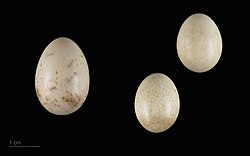Handbook and guide to the British birds on exhibition in the Lord Derby Natural History Museum, Liverpool (1914) (14750499622)
Identifier: handbookguidetob00live (find matches)
Title: Handbook and guide to the British birds on exhibition in the Lord Derby Natural History Museum, Liverpool
Year: 1914 (1910s)
Authors: Liverpool Museum (Liverpool, England)
Subjects: Liverpool Museum (Liverpool, England) Birds
Publisher: Liverpool, C. Tinling
Contributing Library: Smithsonian Libraries
Digitizing Sponsor: Smithsonian Libraries
View Book Page: Book Viewer
About This Book: Catalog Entry
View All Images: All Images From Book
Click here to view book online to see this illustration in context in a browseable online version of this book.
Text Appearing Before Image:
ts and their larvse, especially hairy caterpillars. No nest is builtand the female Cuckoo lays her egg on the ground, conveying it in herbill to the nest of a foster parent:—Hedge Sparrow, Wagtail, SedgeWarbler, Reed Warbler, Meadow Pipit (as here shown) and others.Soon after the young cuckoo is hatched, it ejects the other nestlings.Four to six eggs are laid in a season, and the eggs laid by differentindividuals vary greatly in colour, sometimes resembling those of thefoster-parent (see British Bird Egg Cabinet, drawer 7). Case 159.—The male bird is being mobbed by Meadow Pipits(mobbing by smaller birds is common, probablybecause the Cuckoo is mistaken for a bird of prey).Both in size and colouration there is considerableresemblance between Sparrow Hawks and Cuckoos. Case 160.—The female is seen depositing her egg in the MeadowPipits nest. It is suggested that the egg is laid onthe ground, and carried in the beak to the nest asseen in the group, the beak being specially adapted
Text Appearing After Image:
21 to hold the egg firmly, and yet without risk ofdamaging the tender shell. On the other handother observers state that the egg is conveyed to thenest by the claws. It is interesting to note that theegg may be a good match in colour, with those of thefoster parents. This may have been brought aboutby natural selection, as probably each individualcuckoo always chooses the nest of the same speciesfor all her eggs. Case 161.—The young Cuckoo is here seen occupying the nest of(a) the Hedge Sparrow, and (6) the Wagtail. Inboth instances the foster-mothers are shown convey-ing food to the usurper. Case 162. SEDGE-WARBLER (Acrocephalus phragmitis).Local name : Water Nanny. A common summer visitor, generally distributed over the BritishIslands from the latter half of April till the end of September. Itfrequents meres and reedy swamps, and the nest is generally placedin a low bush or among rank herbage by the side of some stream orditch. It is composed of moss and coarse grass, and the insi
Note About Images
Relevantní obrázky
Relevantní články
Kukačka obecnáKukačka obecná je druh ptáka z řádu kukaček (Cuculiformes) a čeledi kukačkovitých (Cuculidae). V Evropě jde společně s příbuznou kukačkou chocholatou o jediného zástupce kukaček a současně o jediný ptačí druh patřící mezi obligátní hnízdní parazity. Zbarvením je tento pták velikosti holuba vcelku nevýrazný, převážně šedý nebo hnědý s bílým, tmavě pruhovaným břichem a žlutýma nohama. Samci se na jaře ozývají charakteristickým a pronikavým voláním „ku–ku“, které kukačce dalo jméno v mnoha světových jazycích. .. pokračovat ve čtení


















